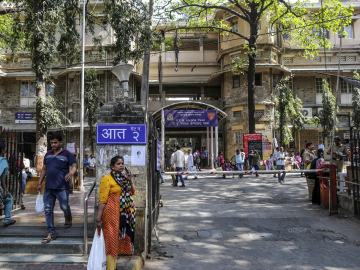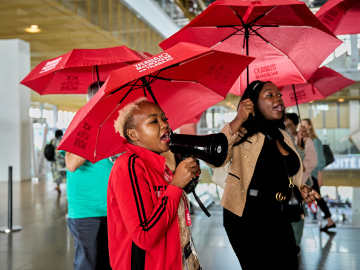When COVID-19 Hit, Nunavik’s Midwives Delivered
Glancing nervously towards the clock, Brenda Epoo, an experienced midwife and perinatal service coordinator, reaches for a folded set of fresh bed sheets. With only 5 minutes before the next patient arrives, Epoo must handwash all of her instruments and change the linens on the bed in a local home in Inukjuak.
When the pandemic hit, Epoo’s midwifery services in Nunavik, in northern Quebec, became even more indispensable as the looming threat of COVID-19 resulted in interregional travel restrictions, cancelations of medical services and understaffing at Nunavik’s hospital in Puvirnituq. In March 2020, in anticipation of COVID-19 reaching Nunavik, the maternities in Inukjuak, Salluit and Puvirnituq were moved out of the hospital to local homes or motels to free up hospital beds. Only the ‘maternity’ in Salluit has since returned to the health centre.
By early April, in response to rising COVID-19 cases in Quebec, all non-essential flights in and out of Nunavik and between communities were canceled. “There was a time when nobody left and nobody came,” recalls Kimberly Moorhouse, another Nunavik midwife. “The southern nurses and doctors had to stay longer than they were supposed to because there were no people to replace them.” These restrictions proved effective, however, with only a cumulative 17 local cases of COVID-19 reported by July 2020, per a Nunavik Regional Board of Health and Social Services’ press release.
The pandemic forced the midwives to learn to cope with an expanding list of restrictions. Beginning in April, Inuit women traveling within the province to Puvirnituq or Montreal for medical appointments were required to travel without a companion and to quarantine for 14 days upon their return. “There were many missed ultrasound appointments as women did not want to take flights to Puvirnituq [where COVID-19 was spreading],” reports Djenae Gaspard, the professional service coordinator at Puvirnituq’s Inuulitsivik Hospital. “Isolating for 2 weeks upon their return is pretty difficult for mothers to accept, especially if they have a new little baby with them. We had 2 births attended by nurses in smaller communities. The women were afraid. They just did not want to leave.”
In response to women’s mounting fear and resistance to travel, Epoo and her colleagues in Inukjuak opened their doors to women who would not travel to Puvirnituq or Montreal. “There are a lot of people who didn’t want to go to Montreal and women from smaller communities who refused to go to Puvirnituq. These situations were really challenging and we encouraged the women to come to deliver in Inukjuak or Salluit instead,” says Epoo.
By summer, the local midwives were desperate for support, according to Toronto-based midwife Patrice Latka, who has worked to support local midwives in Nunavik for many years, “There was a full schedule for southern midwives over the summer, but they canceled because of COVID-19.”
Gone are the days of bustling and crowded delivery rooms. Now women are only allowed one companion with them during labor. “We used to see women first at 8 weeks pregnant to listen to the fetal heartbeat. But now they come at 12 weeks for the first visit and they can’t have anyone with them during these prenatal appointments,” says Moorhouse.
Now, a year since the pandemic upended everything, midwifery in Nunavik has adapted to the new normal. Southern midwives have returned, provided they complete a 14-day quarantine outside of working hours, and the immunization of Inuit midwives against COVID-19 has begun. In spite of the additional stressors over the pandemic, Epoo and her colleagues are determined to provide high quality of care to the nearly 200 women that are delivered by midwives in Nunavik each year and to maintain the hard-won progress they have achieved over the last few decades.
For her part, Latka hopes that one day her job will be obsolete. “People living in these communities need to be the ones providing care. They need to be the doctors, they need to be the nurses, they need to be the midwives and not reliant on a white savior who arrives to provide care,” she says.
The Inuit midwives hope to ensure the stability and longevity of the program by expanding midwifery services to additional communities and training more local midwives. Epoo has dreams of opening a new midwifery clinic in another community in Nunavik, noting, “It affects our services here when a midwife has to leave for appointments in another community.” She’d love to have at least one or two more midwifery clinics.
But expanding the midwifery education program will not be easy, explains Latka. “It is important to try to figure out how to bring more education up here, but it’s hard because the internet is not great. And the weather is really harsh and it’s really difficult to travel; there are so many challenges and barriers.”
According to Gaspard, the budget for Puvirnituq’s midwifery education program is limited, so even maintaining the resources for the existing program and keeping students enrolled is complicated. Organizations such as the National Aboriginal Council of Midwives continue to advocate for expanded local midwifery training programs for Indigenous women in Canada.
Despite the additional challenges they have faced during COVID-19, Epoo and her colleagues are committed to empowering their communities and improving maternal and newborn health—and the COVID-19 pandemic has only solidified their belief that local training of health care providers is the key to sustainable progress in Nunavik.
Editors’ Note: This is the second article in a 2-part series; see part I, The Midwives with Mettle in Nunavik, here.
Miriam Gladstone is a 2020 Pulitzer Center Campus Consortium Reporting Fellow and a second year student at the McGill University School of Medicine in Montreal. She also holds a Masters of Science in Reproductive and Sexual Health Research from the London School of Hygiene.
Join the 50,000+ subscribers in 170+ countries who rely on Global Health NOW summaries and exclusive articles for the latest public health news. Sign up for our free weekday enewsletter, and please share the link with friends and colleagues: https://www.globalhealthnow.org/subscribe
Twilight in Puvirnituq Town, Nunavik, Canada, March 8, 2006. Image: George, Courtesy of Flickr, Creative Commons License.




